

Some years ago I had an opportunity to look through the Order, Quotation and Foundry Books as I had them out on loan (being family archives). With hundreds and hundreds of pages it was not possible to examine each in any detail but occasionally a name, a place, or a drawing caught my eye and I photographed the page for future reference. Even these images amounted to hundreds and over time I have sorted some items of interest or that still may be around today or may prompt memories for some. Where possible I have added images, entries of diagrams – lines and lines of text can be offputting. Often the items are unusual or ‘one offs’ but they usually date from the period of William IV (1830 – 37) or Victoria (1837 – 1901) so any that exist to this day, and some do, then they are well over 100 years old.
My first discovery relates to a small piece of work carried out by the machine shop. It’s not what was made but for whom it was made.

 This was based at Teignmouth and the work carried out in September 1910 was a requirement for some Whitworth threaded studs, “To be ready if possible for Monday morning”.
This was based at Teignmouth and the work carried out in September 1910 was a requirement for some Whitworth threaded studs, “To be ready if possible for Monday morning”.
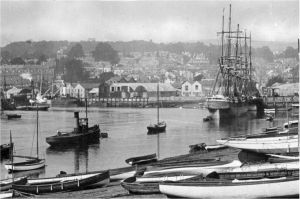 Located also at Teignmouth was a smaller tug named ‘Teign’. They were often featured in newspaper articles as their services were occasionally called upon to haul vessels off the approaches’ sand banks and the like. She was built in 1892 with a gross registered tonnage of 50 tons. Work on vessels was not a one-off for the company as they often performed work on other vessels or were engaged by such companies as Philip & Son of Kingswear (1858 – late 1990s) at whose facilities many vessels were overhauled and repaired. We have an image of her at Shaldon, the image is reproduced with permission and is copyright Alec Collyer Archive.
Located also at Teignmouth was a smaller tug named ‘Teign’. They were often featured in newspaper articles as their services were occasionally called upon to haul vessels off the approaches’ sand banks and the like. She was built in 1892 with a gross registered tonnage of 50 tons. Work on vessels was not a one-off for the company as they often performed work on other vessels or were engaged by such companies as Philip & Son of Kingswear (1858 – late 1990s) at whose facilities many vessels were overhauled and repaired. We have an image of her at Shaldon, the image is reproduced with permission and is copyright Alec Collyer Archive.
The Regia Steam Tug Company Ltd went into liquidation in 1918
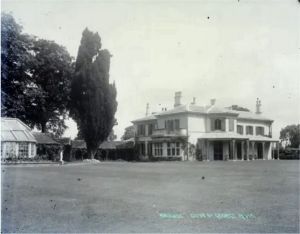 This is not for The Knowle at Sidmouth but for an identically named property at Clyst St George. This property was once in the ownership of Samuel Parr in the early to mid 1800s, who was, amongst other things, a Magistrate. The property was subsequently in the ownership (1950s) of a William Clulow Sim JP (born 1832 Madras) and who was at onetime in the Madras Civil Service. He was married on 1 July 1856 in Topsham.
This is not for The Knowle at Sidmouth but for an identically named property at Clyst St George. This property was once in the ownership of Samuel Parr in the early to mid 1800s, who was, amongst other things, a Magistrate. The property was subsequently in the ownership (1950s) of a William Clulow Sim JP (born 1832 Madras) and who was at onetime in the Madras Civil Service. He was married on 1 July 1856 in Topsham.
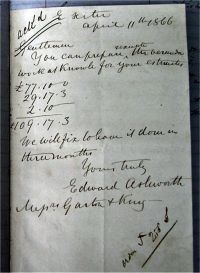 In April 1866 he accepted Garton & King’s estimate for the construction of a Verandah and a Greenhouse at The Knowle. The letter (right) accepts the estimated cost of £109.17.03d and states the work to be completed in 3 months. There exist about four pages of the written estimate and the materials and design to be used, the structure of the roof and the angles as well as a diagram of the design of the brackets to the pilaster (an architectural element used to give the appearance of a supporting column) as well as detail about waterproof covering of the verandah and the design of the joints.
In April 1866 he accepted Garton & King’s estimate for the construction of a Verandah and a Greenhouse at The Knowle. The letter (right) accepts the estimated cost of £109.17.03d and states the work to be completed in 3 months. There exist about four pages of the written estimate and the materials and design to be used, the structure of the roof and the angles as well as a diagram of the design of the brackets to the pilaster (an architectural element used to give the appearance of a supporting column) as well as detail about waterproof covering of the verandah and the design of the joints.
Fortunately the building survives to this day together with its Verandah. The present lockdown (2021) prevents me from discovering whether the Greenhouse seen in the Chapman Black & White Postcard is still there.
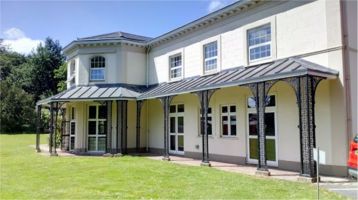 |
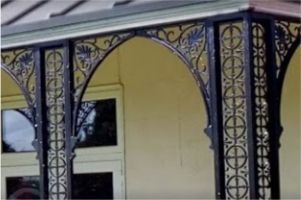 |
 Whilst researching this work I came across this newspaper cutting from the Exeter & Plymouth Gazette – if you should see a white terrier with two brown ears that answers to the name Whisky you’re probably seeing a GHOST!
Whilst researching this work I came across this newspaper cutting from the Exeter & Plymouth Gazette – if you should see a white terrier with two brown ears that answers to the name Whisky you’re probably seeing a GHOST!
Knowle House is now the Headquarters of the Devon & Somerset Fire & Rescue Service. The house remains but the surrounds are a hotch potch of modern single storey annexes, car parks and extensions. I expect that if William Clulow Sim, an avid cricketer, were able to see it now he would be somewhat displeased.
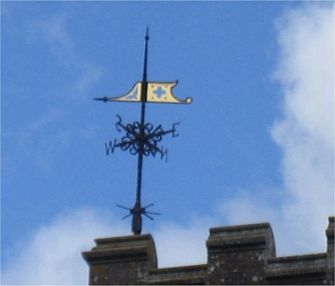 Quite a few images survive of drawings for Weathervanes. The one on the Blundells School Chapel is still in situ. The drawing is undated but knowing how competent the Archivist at Blundells is I’m sure there’s a record of the date somewhere, but I would guess about 1880. Sorry for the out-of-focus photograph of the Weathervane which was taken about 5 years ago.
Quite a few images survive of drawings for Weathervanes. The one on the Blundells School Chapel is still in situ. The drawing is undated but knowing how competent the Archivist at Blundells is I’m sure there’s a record of the date somewhere, but I would guess about 1880. Sorry for the out-of-focus photograph of the Weathervane which was taken about 5 years ago.
Weathervanes often remain undisturbed perched on rooftops or church towers and other high buildings. I have include some photographs of weathervanes from the archives, but as yet I cannot discover where they were erected or even if they still exist, though I should think there is an even chance that they still do.
If YOU recognise one of these and can contact me as to where it is located, please contact me and I will add the information to the page. Have a look on Churches Chapels or Schools, maybe on one of the grander mansions in Devon or the South West. If you can forward a reasonable image of the building on which it is erected and the location, I will include the image with the original photo on this page.
I am going slightly against the grain as this particular piece of ornamentation has now been removed and the building long since demolished in the creation of Exeter’s Guildhall Shopping Centre. Possibly not an object that was often looked at but it may well be in the memory of those that frequented the area up until 1959 when the Police moved out of the Waterbeer Street premises to the new facility in Heavitree Road. Exonians born before 1950 may recall having seen it. What is it and where was it? As you can see from the long rectangular plan drawing from our archives (far right), it was somewhat ‘over the top’ in terms for capping off the conical turret that was located at the corner of the building where Pancras Street met Waterbeer Street.
Many images of the Waterbeer Street Police Station survive but almost all have this structure missing from the image as usually there was not enough room to fit it in the picture! The original drawings are full size, and even photographing the drawings was a bit challenging. The writing at the top of the plan states “Police Station, Exeter. Finial for top of ventilating turret.” A Finial is, in architecture, the decorative upper termination of a pinnacle, gable end, buttress, canopy, or spire. The Drawing is by John M. Pinn and is dated 14th January 1888. The Illustration at the bottom of the drawing is a cross section at point A to A at the top of the plan. The yellow filled square object is the cross sectional view at points B to B. The text refers to the central blue circle ‘C’ which is a rod and it states ‘The rod ‘C’ to extend 2 foot down into (the) post and be secured with a screw end and nut”. It was not a weathervane. If you view the Film you can see it in the view at around 1.24 – 1.26 minutes into the video. Much of the film covers this area, see map.
February 2021
Top of page
See also:
Third Rail, Hand Rail, Finials and Freebies
Oddities, Stories and Trivia
Devon & Exeter Hospital — Power to the Pumps
Waterbeer Street Foundry — Saltram House
Sitemap / Contents